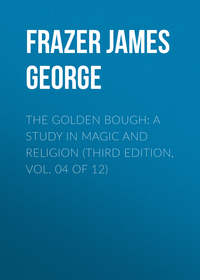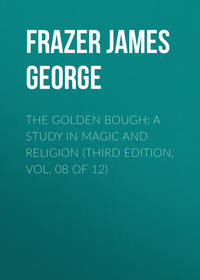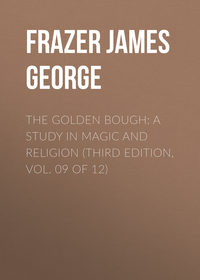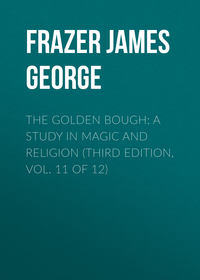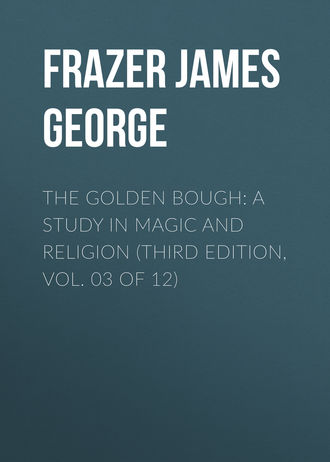 полная версия
полная версияThe Golden Bough: A Study in Magic and Religion (Third Edition, Vol. 03 of 12)
For the reason, see E. Shortland, Traditions and Superstitions of the New Zealanders, pp. 112 sq., 292; E. Tregear, “The Maoris of New Zealand,” Journal of the Anthropological Institute, xix. (1890) p. 118.
843
F. J. Gillen, in Report of the Horn Scientific Expedition to Central Australia, pt. iv. p. 182.
844
Native Tribes of South Australia, p. 186.
845
Mrs. James Smith, The Booandik Tribe, p. 5.
846
J. G. F. Riedel, De sluik- en kroesharige rassen tusschen Selebes en Papua, p. 450.
847
J. G. F. Riedel, op. cit. p. 139, compare p. 209.
848
F. J. Wiedemann, Aus dem innern und äussern Leben der Ehsten, p. 475.
849
Miss Mary H. Kingsley, Travels in West Africa, p. 447. Conversely among the central Australian tribes women are never allowed to witness the drawing of blood from men, which is often done for purposes of decoration; and when a quarrel has taken place and men's blood has been spilt in the presence of women, it is usual for the man whose blood has been shed to perform a ceremony connected with his own or his father or mother's totem. See Spencer and Gillen, Native Tribes of Central Australia, p. 463.
850
A. B. Ellis, The Yoruba-speaking Peoples of the Slave Coast, pp. 125 sq.
851
E. B. Cross, “On the Karens,” Journal of the American Oriental Society, iv. (1854) pp. 311 sq.
852
A. Bastian, Die Völker des östlichen Asien, ii. 256, iii. 71, 230, 235 sq. The spirit is called kwun by E. Young (The Kingdom of the Yellow Robe, pp. 75 sqq.). See below, pp. 266 sq.
853
Herodotus, ix. 110. This passage was pointed out to me by the late Mr. E. S. Shuckburgh of Emmanuel College, Cambridge.
854
Plutarch, Quaestiones Romanae, 100. Plutarch's words (μάλιστα ῥύπτεσθαι τὰς κεφαλὰς καὶ καθαίρειν ἐπιτηδεύουσι) leave room to hope that the ladies did not strictly confine their ablutions to one day in the year.
855
P. J. de Arriaga, Extirpación de la Idolatria del Piru (Lima, 1621), pp. 28, 29.
856
A. Bastian, op. cit. ii. 150; Sangermano, Description of the Burmese Empire (Rangoon, 1885), p. 131; C. F. S. Forbes, British Burma, p. 334; Shway Yoe, The Burman (London, 1882), i. 91.
857
E. Young, The Kingdom of the Yellow Robe (Westminster, 1898), p. 131.
858
J. Moura, Le Royaume du Cambodge, i. 178, 388.
859
Duarte Barbosa, Description of the Coasts of East Africa and Malabar in the beginning of the Sixteenth Century (Hakluyt Society, 1866), p. 197.
860
This I learned in conversation with Messrs. Roscoe and Miller, missionaries to Uganda. The system of totemism exists in full force in Uganda. No man will eat his totem animal or marry a woman of his own totem clan. Among the totems of the clans are the lion, leopard, elephant, antelope, mushroom, buffalo, sheep, grasshopper, crocodile, otter, beaver, and lizard. See Totemism and Exogamy, ii. 472 sqq.
861
David Porter, Journal of a Cruise made to the Pacific Ocean in the U.S. Frigate “Essex” (New York, 1822), ii. 65.
862
Vincendon-Dumoulin et C. Desgraz Îles Marquises (Paris, 1843), p. 262.
863
Le P. Matthias G – , Lettres sur les Îles Marquises (Paris, 1843), p. 50.
864
G. H. von Langsdorff, Reise um die Welt (London, 1812), i. 115 sq.
865
Max Radiguet, Les Derniers Sauvages (Paris, 1882), p. 156.
866
Capt. James Cook, Voyages, v. 427 (London, 1809).
867
Jules Remy, Ka Mooolelo Hawaii, Histoire de l'Archipel Havaiien (Paris and Leipsic, 1862), p. 159.
868
W. Ellis, Polynesian Researches2 (London, 1832-36), iii. 102.
869
James Wilson, A Missionary Voyage to the Southern Pacific Ocean (London, 1799), pp. 354 sq.
870
W. Colenso, “The Maori Races of New Zealand,” p. 43, in Transactions and Proceedings of the New Zealand Institute, 1868, vol. i. (separately paged).
871
R. Taylor, To Ika a Maui, or New Zealand and its Inhabitants,2 p. 165. We have seen that under certain special circumstances common persons also are temporarily forbidden to touch their heads with their hands. See above, pp. 146, 156, 158, 160, 183.
872
R. Taylor, l. c.
873
E. Shortland, The Southern Districts of New Zealand (London, 1851), p. 293; id., Traditions and Superstitions of the New Zealanders, pp. 107 sq.
874
J. Dumont D'Urville, Voyage autour du monde et à la recherche de La Pérouse, exécuté sous son commandement sur la corvette “Austrolabe”: histoire du voyage, ii. 534.
875
R. A. Cruise, Journal of a Ten Months' Residence in New Zealand (London, 1823), p. 187; J. Dumont D'Urville, op. cit. ii. 533; E. Shortland, The Southern Districts of New Zealand, p. 30.
876
Herodotus, i. 187.
877
H. France, “Customs of the Awuna Tribes,” Journal of the African Society, No. 17 (October, 1905), p. 39.
878
Agathias, Hist. i. 3; J. Grimm, Deutsche Rechtsalterthümer,3 pp. 239 sqq. Compare F. Kauffmann, Balder (Strasburg, 1902), pp. 209 sq. The story of the Phrygian king Midas, who concealed the ears of an ass under his long hair (Aristophanes, Plutus, 287; Ovid, Metam. xi. 146-193) may perhaps be a distorted reminiscence of a similar custom in Phrygia. Parallels to the story are recorded in modern Greece, Ireland, Brittany, Servia, India, and among the Mongols. See B. Schmidt, Griechische Märchen, Sagen und Volkslieder, pp. 70 sq., 224 sq.; Grimm's Household Tales, ii. 498, trans. by M. Hunt; Patrick Kennedy, Legendary Fictions of the Irish Celts, pp. 248 sqq. (ed. 1866); A. de Nore, Coutumes, mythes, et traditions des provinces de la France, pp. 219 sq.; W. S. Karadschitsch, Volksmärchen der Serben, No. 39, pp. 225 sqq.; North Indian Notes and Queries, iii. p. 104, § 218; B. Jülg, Mongolische Märchen-Sammlung, No. 22, pp. 182 sqq.; Sagas from the Far East, No. 21, pp. 206 sqq.
879
Gregory of Tours, Histoire ecclésiastique des Francs, iii. 18, compare vi. 24 (Guizot's translation).
880
Dr. Hahl, “Mitteilungen über Sitten und rechtliche Verhältnisse auf Ponape,” Ethnologisches Notizblatt, ii. Heft 2 (Berlin, 1901), p. 6.
881
Manuscrit Ramirez, Histoire de l'origine des Indiens qui habitent la Nouvelle Espagne (Paris, 1903), p. 171; J. de Acosta, Natural and Moral History of the Indies, ii. 365 (Hakluyt Society); A. de Herrera, General History of the vast Continent and Islands of America, iii. 216 (Stevens's translation). The author of the Manuscrit Ramirez speaks as if the rule applied only to the priests of the god Tezcatlipoca.
882
G. M. Dawson, “On the Haida Indians of Queen Charlotte Islands,” in Geological Survey of Canada, Report of Progress for 1878-79, p. 123 b.
883
J. Spieth, Die Ewe-Stämme, p. 229.
884
Missions Catholiques, xxv. (1893) p. 266.
885
M. Merker, Die Masai (Berlin, 1904), pp. 21, 22, 143.
886
A. W. Nieuwenhuis, Quer durch Borneo, i. 68.
887
Satapatha Brahmana, translated by J. Eggeling, part iii. pp. 126, 128, with the translator's note on p. 126 (Sacred Books of the East, vol. xli.).
888
P. N. Wilken, “Bijdragen tot de kennis van de zeden en gewoonten der Alfoeren in de Minahassa,” Mededeelingen van wege het Nederlandsche Zendelinggenootschap, vii. (1863) p. 126.
889
R. P. Ashe, Two Kings of Uganda (London, 1889), p. 109.
890
Fr. Boas, in Tenth Report on the North-Western Tribes of Canada, p. 45 (separate reprint from the Report of the British Association for 1895).
891
J. G. F. Riedel, De sluik- en kroesharige rassen tusschen Selebes en Papua, p. 137.
892
J. G. F. Riedel, op. cit. pp. 292 sq.
893
W. W. Skeat, Malay Magic, p. 44.
894
Diodorus Siculus, i. 18.
895
W. Robertson Smith, Kinship and Marriage in Early Arabia (Cambridge, 1885), pp. 152 sq.
896
Homer, Iliad, xxiii. 141 sqq. This Homeric passage has been imitated by Valerius Flaccus (Argonaut. i. 378). The Greeks often dedicated a lock of their hair to rivers. See Aeschylus, Choephori, 5 sq.; Philostratus, Heroica, xiii. 4; Pausanias, i. 37. 3, viii. 20. 3, viii. 41. 3. The lock might be at the side or the back of the head or over the brow; it received a special name (Pollux, ii. 30).
897
S. W. Tromp, “Een Dajaksch Feest,” Bijdragen tot de Taal- Land- en Volkenkunde van Nederlandsch-Indië, xxxix. (1890) p. 38.
898
T. Arbousset et F. Daumas, Relation d'un voyage d'exploration, p. 565.
899
D. Porter, Journal of a Cruise made to the Pacific Ocean, ii. 120.
900
Tacitus, Germania, 31. Vows of the same sort were occasionally made by the Romans (Suetonius, Julius, 67; Tacitus, Hist. iv. 61).
901
Paulus Diaconus, Hist. Langobard. iii. 7; Gregory of Tours, Histoire ecclésiastique des Francs, v. 15, vol. i. p. 268 (Guizot's translation, Nouvelle Edition, Paris, 1874).
902
W. Ellis, Polynesian Researches,2 iv. 387.
903
Numbers vi. 5.
904
J. A. E. Köhler, Volksbrauch, etc., im Voigtlande, p. 424; W. Henderson, Folk-lore of the Northern Counties, pp. 16 sq.; F. Panzer, Beitrag zur deutschen Mythologie, i. p. 258, § 23; I. V. Zingerle, Sitten, Bräuche und Meinungen des Tiroler Volkes,2 §§ 46, 72; J. W. Wolf, Beiträge zur deutschen Mythologie, i. p. 208, § 45, p. 209 § 53; O. Knoop, Volkssagen, Erzählungen, etc., aus dem östlichen Hinterpommern, p. 157, § 23; E. Veckenstedt, Wendische Sagen, Märchen und abergläubische Gebräuche, p. 445; J. Haltrich, Zur Volkskunde der Siebenbürger Sachsen, p. 313; E. Krause, “Abergläubische Kuren und sonstiger Aberglaube in Berlin,” Zeitschrift für Ethnologie, xv. (1883) p. 84.
905
Panjab Notes and Queries, ii. p. 205, § 1092.
906
G. Gibbs, “Notes on the Tinneh or Chepewyan Indians of British and Russian America,” in Annual Report of the Smithsonian Institution, 1866, p. 305; W. Dall, Alaska and its Resources, p. 202. The reason alleged by the Indians is that if the girls' nails were cut sooner the girls would be lazy and unable to embroider in porcupine quill-work. But this is probably a late invention like the reasons assigned in Europe for the similar custom, of which the commonest is that the child would become a thief if its nails were cut.
907
J. Roscoe, “Further Notes on the Manners and Customs of the Baganda,” Journal of the Anthropological Institute, xxxii. (1902) p. 30.
908
Lieut. Herold, “Religiöse Anschauungen und Gebräuche der deutschen Ewe-Neger,” Mittheilungen aus den Deutschen Schutzgebieten, v. 148 sq.
909
S. J. Curtiss, Primitive Semitic Religion To-day (Chicago, etc., 1902), p.153.
910
A. C. Kruyt, “Het koppensnellen der Toradja's,” Verslagen en Mededeelingen der konink. Akademie van Wetenschapen, Afdeeling Letterkunde, iv. Reeks, iii. 198 n2 (Amsterdam, 1899).
911
R. Römer, “Bijdrage tot de Geneeskunst der Karo-Batak's,” Tijdschrift voor Indische Taal- Land- en Volkenkunde, i. (1908) p. 216.
912
O. Knoop, Volkssagen, Erzählungen, etc., aus dem östlichen Hinterpommern (Posen, 1885), p. 157, § 23.
913
J. W. Wolf, Beiträge zur deutschen Mythologie, i. p. 209, § 57.
914
Rev. Lorimer Fison, in a letter to the author, dated August 26, 1898.
915
From the report of a lecture delivered in Melbourne, December 9, 1898, by the Rev. H. Worrall, of Fiji, missionary. The newspaper cutting from which the above extract is quoted was sent to me by the Rev. Lorimer Fison in a letter, dated Melbourne, January 9, 1899. Mr. Fison omitted to give the name and date of the newspaper.
916
R. Taylor, Te Ika a Maui, or New Zealand and its Inhabitants2 (London, 1870), pp. 206 sqq.
917
Richard A. Cruise, Journal of a Ten Months' Residence in New Zealand (London, 1823), pp. 283 sq. Compare J. Dumont D'Urville, Voyage autour du monde et à la recherche de La Pérouse: histoire du voyage (Paris, 1832), ii. 533.
918
E. Shortland, Traditions and Superstitions of the New Zealanders, pp. 108 sqq.; R. Taylor, l. c.
919
G. F. Angas, Savage Life and Scenes in Australia and New Zealand (London, 1847), ii. 90 sq.
920
J. Moura, Le Royaume du Cambodge, i. 226 sq.
921
See above, p. 3.
922
See above, p. 252.
923
E. Young, The Kingdom of the Yellow Robe (Westminster, 1898), pp. 64 sq., 67-84. I have abridged the account of the ceremonies by omitting some details. For an account of the ceremonies observed at cutting the hair of a young Siamese prince, at the age of thirteen or fourteen, see Mgr. Bruguière, in Annales de l'Association de la Propagation de la Foi, v. (1831) pp. 197 sq.
924
The aboriginal tribes of Central Australia form an exception to this rule; for among them no attempt is made to injure a person by performing magical ceremonies over his shorn hair. See Spencer and Gillen, Northern Tribes of Central Australia, p. 478.
925
See The Magic Art and the Evolution of Kings, vol. i. pp. 52-54, 174 sqq.
926
C. Martin, “Über die Eingeborenen von Chiloe,” Zeitschrift für Ethnologie, ix. (1877) p. 177.
927
Vincendon-Dumoulin et C. Desgraz, Îles Marquises (Paris, 1843), pp. 247 sq.
928
D. Porter, Journal of a Cruise made to the Pacific Ocean2 (New York, 1882), ii. 188.
929
R. Taylor, Te Ika a Maui, or New Zealand and its Inhabitants,2 pp. 203 sq.; A. S. Thomson, The Story of New Zealand (London, 1859), i. 116 sq.
930
R. Brough Smyth, Aborigines of Victoria, i. 468 sq.
931
J. Dawson, Australian Aborigines, p. 36.
932
A. W. Howitt, “On Australian Medicine-men,” Journal of the Anthropological Institute, xvi. (1887) p. 27. Compare id., Native Tribes of South-East Australia, pp. 360 sq.
933
E. Palmer, “Notes on some Australian Tribes,” Journal of the Anthropological Institute, xiii. (1884) p. 293.
934
Lucian, Dial. meretr. iv. 4 sq.
935
Apuleius, Metamorph. iii. 16 sqq. For more evidence of the same sort, see Th. Williams, Fiji and the Fijians,2 i. 248; James Bonwick, Daily Life of the Tasmanians, p. 178; James Chalmers, Pioneering in New Guinea, p. 187; J. S. Polack, Manners and Customs of the New Zealanders, i. 282; A. Bastian, Die Völker des östlichen Asien, iii. 270; G. H. von Langsdorff, Reise um die Welt, i. 134 sq.; W. Ellis, Polynesian Researches,2 i. 364; A. B. Ellis, Ewe-speaking peoples of the Slave Coast, p. 99; R. H. Codrington, The Melanesians, p. 203; K. von den Steinen, Unter den Naturvölkern Zentral-Brasiliens, p. 343; Miss Mary H. Kingsley, Travels in West Africa, p. 447; I. V. Zingerle, Sitten, Bräuche und Meinungen des Tiroler Volkes,2 § 178; R. Andree, Ethnographische Parallelen und Vergleiche, Neue Folge, pp. 12 sqq.; E. S. Hartland, Legend of Perseus, ii. 64-74, 132-139.
936
R. F. Kaindl, “Neue Beiträge zur Ethnologie und Volkeskunde der Huzulen,” Globus, lxix. (1896) p. 94.
937
E. Meier, Deutsche Sagen, Sitten und Gebräuche aus Schwaben, p. 509; A. Birlinger, Volksthümliches aus Schwaben, i. 493; F. Panzer, Beitrag zur deutschen Mythologie, i. 258; J. A. E. Köhler, Volksbrauch, etc., im Voigtlande, p. 425; A. Witzschel, Sagen, Sitten und Gebräuche aus Thüringen, p. 282; I. V. Zingerle, op. cit. § 180; J. W. Wolf, Beiträge zur deutschen Mythologie, i. p. 224, § 273. A similar belief prevails among the gypsies of Eastern Europe (H. von Wlislocki, Volksglaube und religiöser Brauch der Zigeuner, p. 81).
938
I. V. Zingerle, op. cit. § 181.
939
Charlotte Latham, “Some West Sussex Superstitions,” Folk-lore Record, i. (1878) p. 40.
940
J. G. Campbell, Superstitions of the Highlands and Islands of Scotland (Glasgow, 1900), p. 237.
941
W. H. R. Rivers, The Todas (London, 1906), pp. 268 sq.
942
I. V. Zingerle, op. cit. §§ 176, 179.
943
A. Krause, Die Tlinkit-Indianer (Jena, 1885), p. 300.
944
Petronius, Sat. 104.
945
J. G. Campbell, op. cit. pp. 236 sq.
946
A. Bastian, Die deutsche Expedition an der Loango-Küste, i. 231 sq.; id., Ein Besuch in San Salvador, pp. 117 sq.
947
P. B. du Chaillu, Explorations and Adventures in Equatorial Africa (London, 1861), pp. 426 sq.
948
O. Baumann, Usambara und seine Nachbargebiete (Berlin, 1891), p. 141.
949
A. Junod, Les Ba-Ronga (Neuchâtel, 1898), pp. 398-400.
950
W. Stanbridge, “On the Aborigines of Victoria,” Transactions of the Ethnological Society of London, N.S., i. (1861) p. 300.
951
A. C. Hollis, The Nandi (Oxford, 1909), pp. 30, 74 sq.
952
Le P. A. Jaussen, Coutumes des Arabes au pays de Moab (Paris, 1908), pp. 94 sq.
953
2 Samuel, x. 4.
954
2 Samuel, x., xii. 26-31.
955
R. Torday and T. A. Joyce, “Notes on the Ethnography of the Ba-Yaka,” Journal of the Anthropological Institute, xxxvi. (1906) p. 49.
956
François Pyrard, Voyages to the East Indies, the Maldives, the Moluccas, and Brazil, translated by Albert Gray (Hakluyt Society, 1887), i. 110 sq.
957
E. Shortland, Traditions and Superstitions of the New Zealanders, p. 110.
958
J. S. Polack, Manners and Customs of the New Zealanders, i. 38 sq. Compare G. F. Angas, Savage Life and Scenes in Australia and New Zealand (London, 1847), ii. 108 sq.
959
James Wilson, A Missionary Voyage to the Southern Pacific Ocean (London, 1799), p. 355.
960
R. A. Freeman, Travels and Life in Ashanti and Jaman (Westminster, 1898), pp. 171 sq.
961
E. Young, The Kingdom of the Yellow Robe, p. 79.
962
Aulus Gellius, x. 15. 15. The ancients were not agreed as to the distinction between lucky and unlucky trees. According to Cato and Pliny, trees that bore fruit were lucky, and trees which did not were unlucky (Festus, ed. C. O. Müller, p. 29, s. v. Felices; Pliny, Nat. Hist. xvi. 108); but according to Tarquitius Priscus those trees were unlucky which were sacred to the infernal gods and bore black berries or black fruit (Macrobius, Saturn, ii. 16, but iii. 20 in L. Jan's edition, Quedlinburg and Leipsic, 1852).
963
Pliny, Nat. Hist. xvi. 235; Festu, p. 57 ed. C. O. Müller, s. v. Capillatam vel capillarem arborem.
964
M. Quedenfelt, “Aberglaube und halbreligiöse Bruderschaft bei den Marokkanern,” Verhandlungen der Berliner Gesellschaft für Anthropologie, Ethnologie und Urgeschichte, 1886, p. (680).
965
A. Wuttke, Der deutsche Volksaberglaube,2 pp. 294 sq., § 464.
966
W. Mannhardt, Germanische Mythen (Berlin, 1858), p. 630.
967
W. Henderson, Folk-lore of the Northern Counties (London, 1879), p. 17.
968
J. G. F. Riedel, De sluik- en kroesharige rassen tusschen Selebes en Papua, p. 74.




